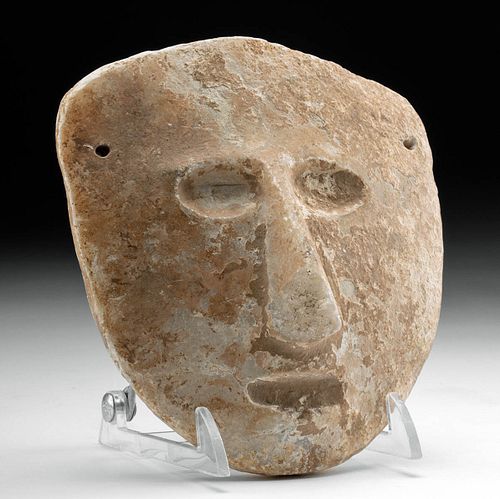Guerrero Sultepec Alabaster Mask w/ Stucco
Lot 104
About Seller
Artemis Fine Arts
686 S Taylor Ave, Ste 106
Louisville, CO 80027
United States
Selling antiquities, ancient and ethnographic art online since 1993, Artemis Gallery specializes in Classical Antiquities (Egyptian, Greek, Roman, Near Eastern), Asian, Pre-Columbian, African / Tribal / Oceanographic art. Our extensive inventory includes pottery, stone, metal, wood, glass and textil...Read more
Estimate:
$4,000 - $6,000
Absentee vs Live bid
Two ways to bid:
- Leave a max absentee bid and the platform will bid on your behalf up to your maximum bid during the live auction.
- Bid live during the auction and your bids will be submitted real-time to the auctioneer.
Bid Increments
| Price | Bid Increment |
|---|---|
| $0 | $25 |
| $300 | $50 |
| $1,000 | $100 |
| $2,000 | $250 |
| $5,000 | $500 |
| $10,000 | $1,000 |
| $20,000 | $2,500 |
| $50,000 | $5,000 |
| $100,000 | $10,000 |
| $200,000 | $20,000 |
About Auction
By Artemis Fine Arts
Jun 15, 2023
Set Reminder
2023-06-15 10:00:00
2023-06-15 10:00:00
America/New_York
Bidsquare
Bidsquare : VARIETY Ancient, Ethno, Native American, Fine Art
https://www.bidsquare.com/auctions/artemis-gallery/variety-ancient-ethno-native-american-fine-art-12990
Antiquities, ethnographic, native american and fine art from cultures encompassing the globe. Artemis Fine Arts info@artemisfinearts.com
Antiquities, ethnographic, native american and fine art from cultures encompassing the globe. Artemis Fine Arts info@artemisfinearts.com
- Lot Description
Pre-Columbian, Central Mexico, Guerrero region, Sultepec, Late Preclassic period, ca. 600 to 100 BCE. A superb example of an alabaster carving from Guerrero, Mexico, a region best known for Mezcala and Chontal sculpture. This fascinating example boasts features particular to the Sultepec, such as a prominent aquiline nose that makes for a marvelous profile. From the front, the piece presents close-set, ovoid eyes and a petite, open mouth. Snowy white remains of stucco are scattered over the vizard, while a pair of drill holes pierce the upper corners, probably intended for fastening the mask to a funerary bundle of the noble elite. Ancient sculptors usually carved "tecalli," also called "alabaster" or aragonite, a calcium carbonate stone found in caves. Size: 5.1" W x 5.5" H (13 cm x 14 cm)
Cf. The Walters Art Museum, accession number 29.4 and Los Angeles County Museum of Art, accession number M.2001.212.20.
Provenance: private Fort Lauderdale, Florida, USA collection; ex-Minerva Gallery; ex-Benjamin Vega, California, USA, acquired in 2006 to 2007; ex-Gene and Virginia George, brought to the USA from 1961 to 1966
All items legal to buy/sell under U.S. Statute covering cultural patrimony Code 2600, CHAPTER 14, and are guaranteed to be as described or your money back.
A Certificate of Authenticity will accompany all winning bids.
We ship worldwide and handle all shipping in-house for your convenience.
#177917Chipping to tip of nose and small area of proper left cheek. Nicks and abrasions as shown, all commensurate with age. Otherwise, intact and excellent with rich earthen deposits.Condition
- Shipping Info
-
All shipping is handled in-house for your convenience. Your invoice from Artemis Gallery will include shipping calculation instructions. If in doubt, please inquire BEFORE bidding for estimated shipping costs for individual items.
-
- Buyer's Premium



 EUR
EUR CAD
CAD AUD
AUD GBP
GBP MXN
MXN HKD
HKD CNY
CNY MYR
MYR SEK
SEK SGD
SGD CHF
CHF THB
THB













